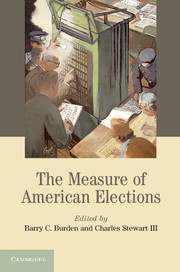Book contents
- Frontmatter
- Contents
- List of figures
- List of tables
- List of contributors
- Acknowledgments
- 1 Introduction to the Measure of American Elections
- 2 Registration and Voting: A View from the Top
- 3 Voter Registration: The Process and Quality of Lists
- 4 Provisional Ballots
- 5 Mail Ballots in the United States: Policy Choice and Administrative Challenges
- 6 Voting from Abroad: Evaluating UOCAVA Voting
- 7 Polling Place Practices and the Voting Experience
- 8 Disability and Election Policies and Practices
- 9 The Performance of Election Machines and the Decline of Residual Votes in the United States
- 10 Voter Confidence as a Metric of Election Performance
- 11 Election Data Transparency
- Appendix
- References
- Index
5 - Mail Ballots in the United States: Policy Choice and Administrative Challenges
Published online by Cambridge University Press: 05 August 2014
- Frontmatter
- Contents
- List of figures
- List of tables
- List of contributors
- Acknowledgments
- 1 Introduction to the Measure of American Elections
- 2 Registration and Voting: A View from the Top
- 3 Voter Registration: The Process and Quality of Lists
- 4 Provisional Ballots
- 5 Mail Ballots in the United States: Policy Choice and Administrative Challenges
- 6 Voting from Abroad: Evaluating UOCAVA Voting
- 7 Polling Place Practices and the Voting Experience
- 8 Disability and Election Policies and Practices
- 9 The Performance of Election Machines and the Decline of Residual Votes in the United States
- 10 Voter Confidence as a Metric of Election Performance
- 11 Election Data Transparency
- Appendix
- References
- Index
Summary
One of the most dramatic changes in voting in the United States over the last two decades has been the growth in the number of voters casting ballots by mail with every successive election cycle. In recent years, an increasing number of states have changed laws to allow voters to cast mail ballots without an excuse, to allow voters to “permanently” request mail ballots for all future elections, and even to switch to “all-mail” voting. Casting ballots by mail involves major changes in the mechanics of obtaining, completing, and submitting ballots compared with the in-person voting system used in the United States for more than a century (Ewald 2009; Keyssar 2009). Given the large and growing proportion of ballots cast by mail, it is vital to understand the effect of these policy changes on election administration and determine how well states administer this distinctive method of voting.
In the 2012 general election, thirty states allowed voters to request mail ballots without providing a reason for using a mail ballot (National Conference of State Legislatures 2012). Eight states allowed voters to request mail ballots for every election (permanent mail voter status). In-person voting was not available in Oregon or Washington: ballots were mailed to all voters that could be returned by mail or in special ballot drop boxes. Twelve additional states allowed counties and cities to conduct similar mail ballot elections in specific types of primary, local, and off-year elections.
- Type
- Chapter
- Information
- The Measure of American Elections , pp. 113 - 140Publisher: Cambridge University PressPrint publication year: 2014
- 10
- Cited by



